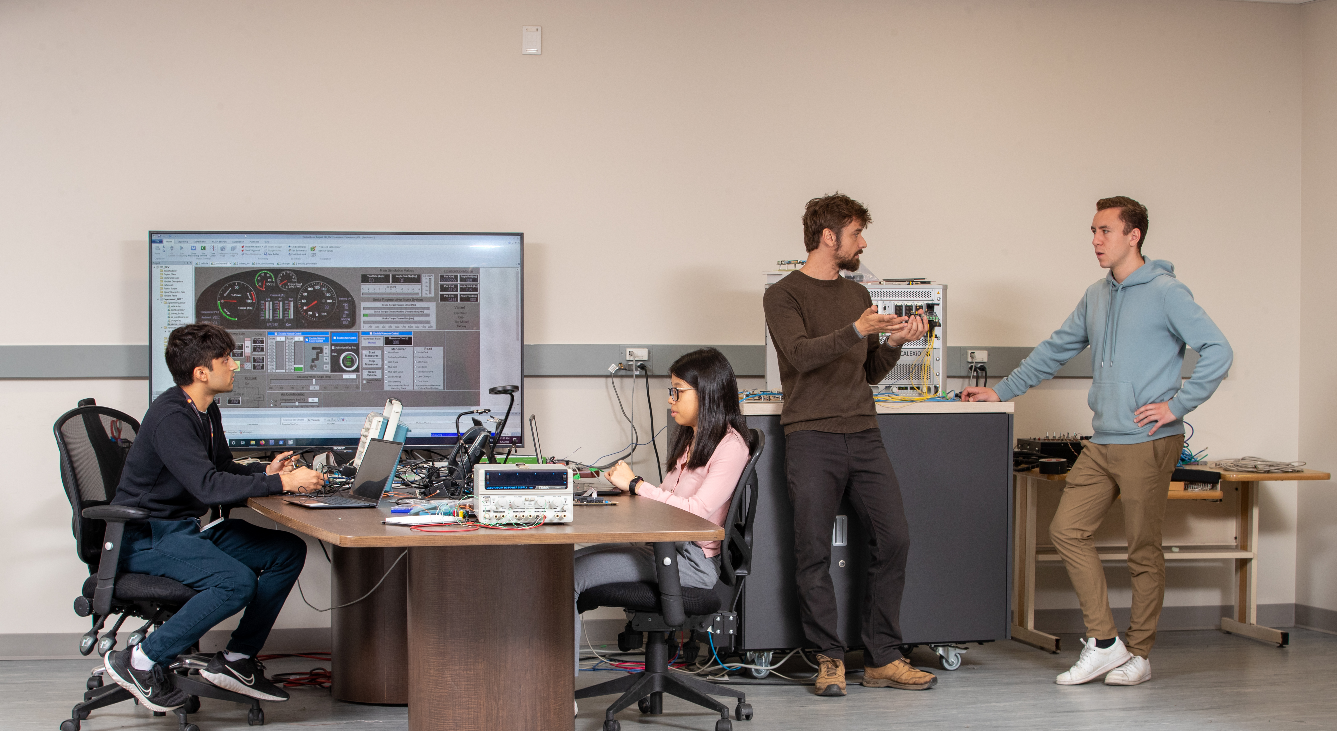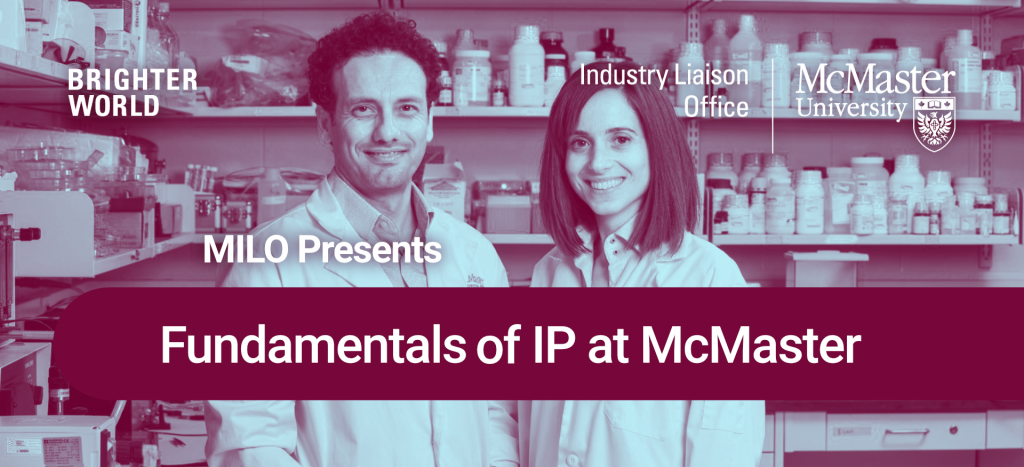The role of MILO in commercialization
The McMaster Industry Liaison Office (MILO) serves as a support system for faculty, staff, and students at McMaster University, Hamilton Health Sciences, and St. Joseph’s Healthcare Hamilton. Its primary objective is to facilitate the transfer of research discoveries to the market. MILO plays a crucial role in creating social and economic benefits by connecting researchers with opportunities for commercialization.
MILO commercializes research through a process called the technology transfer process.
What is technology transfer?
Technology Transfer is the movement of knowledge and discoveries from McMaster University and affiliated Hospitals to the public. It is a core component of the university’s mission to advance knowledge and maximize its beneficial impact on society. It can occur through:
- Research Publications
- Patents
- Graduates Entering the Workforce
- Research Collaborations with 3rd Parties
- Commercialization of IP via a License or Other Agreement with a Third Party
The process of tech transfer is important because it encourages the dissemination of knowledge and innovations to advance society. It is designed in such a way that inventors are rewarded and further encouraged to continue to make new discoveries.
This lesson will focus on the tech transfer process facilitated by MILO through commercialization or other 3rd party agreements.

Technology Transfer Process
The process of commercializing technologies through technology transfer with MILO is composed of 8 key steps:
- Research
- Invention Disclosure Form
- Assessment
- Intellectual Property Protection
- Marketing
- Licensing
- Commercialization
- Revenue
Research
Observations and experiments during research activities often lead to discoveries and inventions, software development and other copyrighted works (see Topic 1 for detailed information about the different types of IP).
Invention Disclosure Form
The written notice of invention to MILO begins the formal technology transfer process. An invention disclosure remains confidential and should fully describe your invention, its story, its critical solution and its advantages and benefits over existing technologies. It also includes information on co-inventors, sponsors of the work, and other essential details.
Disclosure forms are found on the MILO website and are submitted to the MILO business development team. They are available to answer any questions you may have at any point during this process.
Assessment
The period in which the invention is reviewed may include patentability, market, and commercialization assessments. This evaluation process will guide the following steps and determine the best action regarding IP protection and commercialization strategies.
IP Protection
MILO will begin securing IP protection following the strategies created during assessment of the invention.
Patent protection is one such protection, and it begins with filing a patent application. Once filed, however, it requires several years and is often expensive to obtain an issued patent per jurisdiction. Other common forms of IP protection include copyright, trademarks and even trade secrets, each of which is often easier to obtain than a patent. A good IP protection strategy may utilize one or more different types of IP protections best suited for the invention being protected.
Different types of intellectual property can be protected through contracts and material transfer agreements.
Marketing
With the IP inventor’s input and support, MILO will work to identify potential companies and collaborators that have the expertise, resources, and business networks to bring the technology to market. If this leads to creating a new business start-up as the optimal commercialization path, McMaster will license IP rights to that startup company. For more information, see McMaster’s Startup Guide.
Licensing
Once an appropriate and interested company is identified, MILO negotiates the financial and diligence terms for that company to commercialize the technology, usually in the form of a license agreement.
A license is an agreement where the University (Licensor) grants its rights in the technology to a third party (Licensee). The rights may be limited by time, exclusivity, a particular field of use, or a world region.
Commercialization
The licensee continues advancing the technology and makes significant investments in developing the product or service to bring to market. This may include:
- Further research
- Product development
- Scale-up
- Regulatory approvals
- Manufacturing
- Sales and marketing
- Distribution
- Customer support
Revenue
Any revenues received by McMaster are distributed annually to inventors and Institutions, according to the Joint Intellectual Property Policy. McMaster uses the institutional funds to support additional research and to encourage further participation in the technology transfer process.
Role of MILO in technology transfer
MILO helps researchers move their research into society. Specifically, MILO works with the McMaster research community to:
- Evaluate inventions and discoveries for patentability and market potential.
- Protect and manage Intellectual Property (patents, copyright, know-how).
- Identify, market, and license inventions to companies.
- Negotiate research agreements, licenses, non-disclosure agreements (NDAs) and material transfer agreements (MTAs).
- Advance collaborative research by facilitating partnerships with industry.
- Connect with potential industry partners, management, or investors to support start-up companies.
- Coach, mentor, and provide training for entrepreneurs.

Inventor/Author Responsibilities in Tech Transfer
If you are working with MILO to commercialize your IP, you must contact MILO and complete the Disclosure Form to begin the tech transfer process. Contact the MILO business development team when you believe you have discovered or created something unique with potential commercial or research value. You may even contact MILO earlier, to ask questions or discuss an idea you have. When completing the Disclosure Form outlining the details of your invention or discovery. It is essential to list the correct inventors of the invention. Otherwise, this could lead to the invalidation of the patent.
Novelty is vital for patent rights to be granted. Do not publish or present your work before speaking to MILO and completing a Disclosure Form. MILO can help file a patent to protect IP and retain commercial potential before publishing. MILO can also advise on what can safely be presented or shared prior to obtaining IP protection.
There is an obligation to disclose to MILO to ensure that the university meets all funding obligations by sponsors supporting the research.

Ready to commercialize?
You can start by connecting with MILO to discuss your invention and determine the next step for commercializing your IP. Once you are ready, fill out our invention disclosure form.
Summary
- Technology Transfer is the movement of knowledge and discoveries from the University and affiliated Hospitals to the public.
- There are 8 key steps to tech transfer: Research, Invention Disclosure, Assessment, Intellectual Property Protection, Marketing, Licensing, Commercialization, and Revenue.
- MILO assists inventors by managing the tech transfer process, providing mentoring, and answering questions inventors may have.
- It is important for researchers to avoid publishing or presenting patentable materials before speaking to MILO and completing a Disclosure Form.
Register for Fundamentals of IP at McMaster Complete Course

Learn from enhanced and interactive lessons, get access to more content, and receive a certificate of completion.
These modules are created and facilitated by the McMaster Industry Liaison Office (MILO)
Disclaimer: The content of these modules provides general information regarding basic principles of intellectual property law and of commercialization. The content should not be taken as legal or professional advice. For specific advice, seek independent legal counsel.
McMaster University recognizes and acknowledges that it is located on the traditional territories of the Mississauga and Haudenosaunee nations, and within the lands protected by the “Dish with One Spoon” wampum agreement.
© McMaster Industry Liaison Office (MILO), all rights reserved, 2023. For more information, please visit: milo.mcmaster.ca
